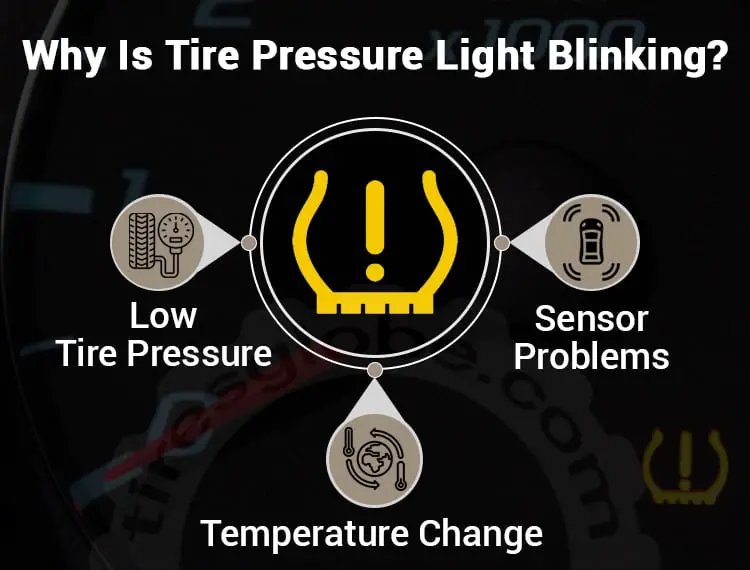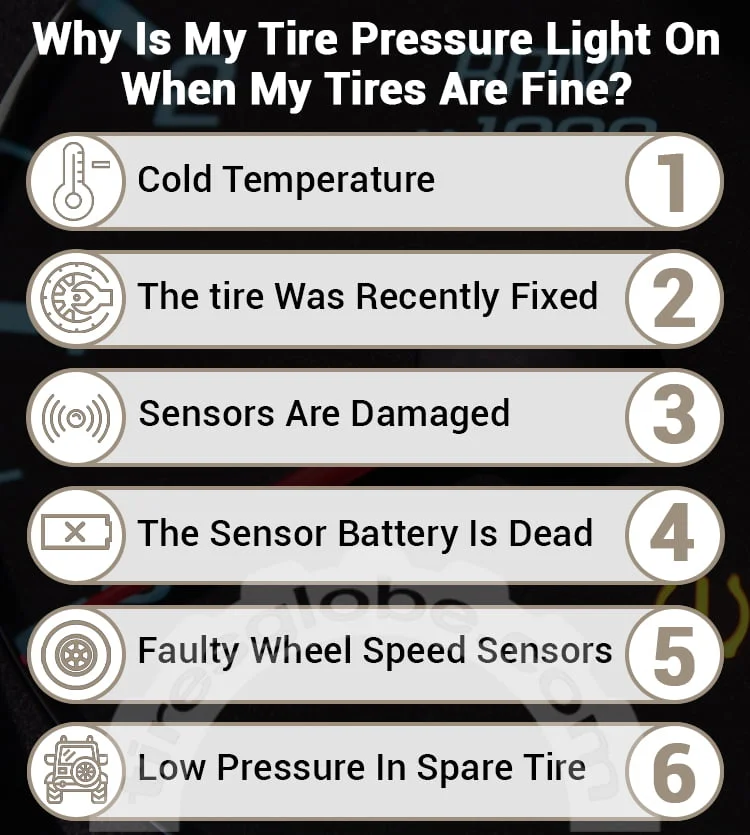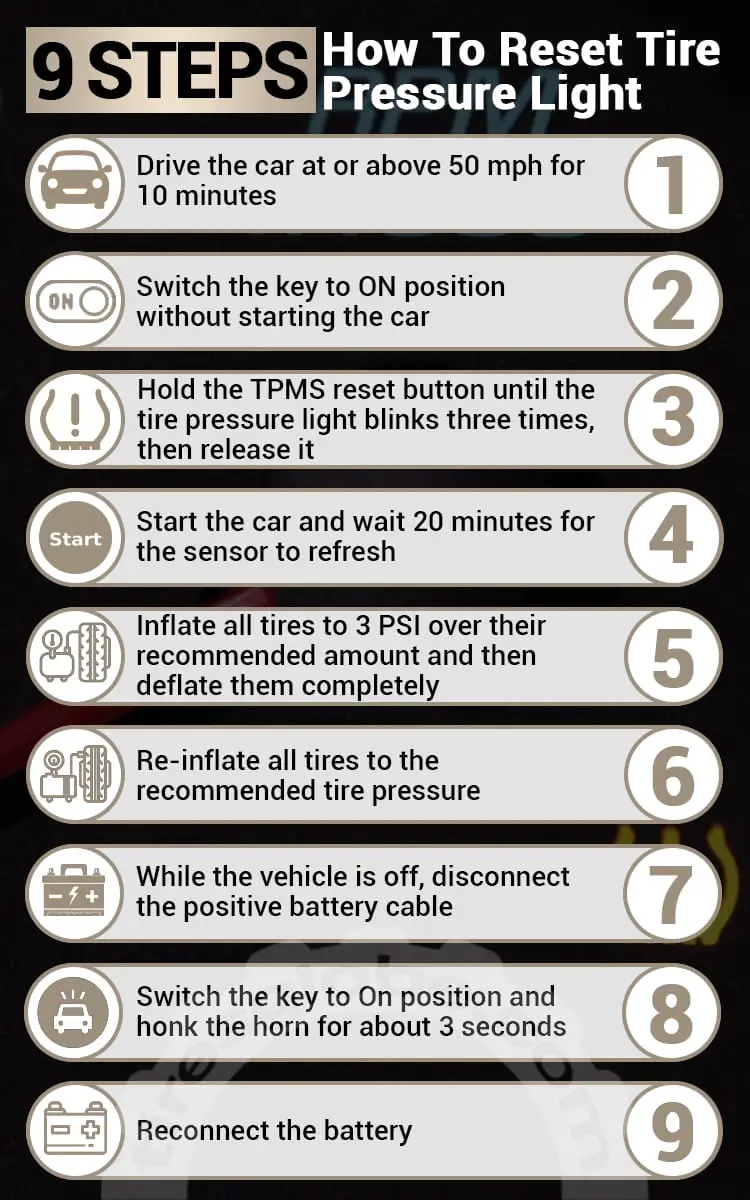Dashboard warning lights are essential for every car owner. As such, we should never ignore warning lights on our dashboards.
But it can be frustrating when you don’t understand what they mean. Or when you can’t think of any reason why they would be on. For instance, you have checked and ensured that your tires’ pressure is as it should be. But the pressure light is still on. “What is happening?” you wonder.
Tire pressure light is one of the least severe warnings. But like all the others, they should not be disregarded. The TPMS light indicates that there is not enough pressure in the tire(s) most of the time. The light goes off on its own as soon as the issues have been addressed. But what if you have checked and it is not due to the tires? Could something else have triggered the light on? Keep reading to learn more about the tire pressure light.
What Is TPMS Light?
TPMS Light means Tire Pressure Monitoring System Light. The TPMS light indicates that something is up with either one or all of your tires. Your TPMS monitors your air pressure and alerts you when it fails.
The TPMS light comes on when the sensor in your tires detects pressure has gone 25% below the recommended range. The indicator’s shape is like a horseshoe with an exclamation mark in the center.
If the TPMS light is on, you should stop driving and check the tires. Ensure the tires are inflated to the right PSI level, which you can find in your car’s manual. Low tire pressure can damage the tires or, worse, result in an accident.
Where Is The TPMS Reset Button?
The TPMS reset button is located beneath the steering wheel in most vehicles. If you are unable to locate it, refer to your car’s manual.
Blinking Tire Pressure Light: What Does It Tell You?
The tire pressure light could either be a solid illumination or a blink.
A solid illumination usually means at least one of the tires isn’t well inflated. However, when it flashes between 60 to 90 seconds and then illuminates to a solid, it means there is something wrong with the tire pressure monitoring system. It may be time to get the system checked.
There are several reasons why the tire pressure light will flash:

Sensor Problems
- There is a chance at least one of the sensors isn’t communicating with the vehicle. Several things could have caused this. Whenever tire pressure is adjusted, the wheels are removed. As such, the TPMS positioning may have been tampered with. The TPMS, therefore, needs to be re-initialized.
- The blinking tire pressure light could indicate that the sensor is damaged, is missing, or dead, and needs its battery changed. It could also mean one of the sensors isn’t installed in the tire correctly.
Low tire pressure
When the pressure in the tires is low, the light may flash. When this happens, pull over first and do so as quickly as possible. Then carefully inspect the tires. With a pressure gauge, check to see that all four tires are at the recommended PSI level. If any is underinflated, use an inflator to correct the situation. Inflate the tire to specification. Or, if you have a spare, change the tire entirely. Then take your vehicle to a mechanic to have it checked and repaired.
Temperature Change
Another explanation for blinking tire pressure light is a temperature change. Temperature changes affect tire pressure. When the weather is cold, the pressure in your tire drops. As such, the tire pressure light will come on. But when it becomes warm, it raises the pressure back up. The lights will go off automatically.
Therefore, to be sure about what exactly is wrong, you need to address each possibility one by one. It may take a while, but you have to do so until you find the answer.
Why Is My Tire Pressure Light On When My Tires Are Fine?
Sometimes the tire pressure light being on is not an indication that something is wrong with your tires. Well then, what does it mean? Why is the tire pressure light on when your tires are in good condition? If your tires are fine, but the pressure light is on, it could be as a result of:

Cold Temperature
Cold temperatures will lower the pressure on your tires. Since tire pressure lights are triggered by low pressure in tires, they will come on.
The tire was recently fixed
If you’ve just had some work done on your tire, say wheel alignment, the sensors’ position is likely disturbed. This could cause the light to stay on. When the sensors are rearranged, the pressure light should go off on its own. If it doesn’t, you may need to go for complete calibration.
Sensors are damaged
Due to your vehicle’s travels over bumps or ditches, the TPMS sensors get damaged over time. If your tires are properly inflated, but the pressure light is still on, it could mean the sensors are damaged. Moreover, damaged sensors could also mean damaged tires.
The sensor battery is dead
Another reason the pressure light isn’t going off could be that the sensors’ battery is dead. The batteries in the sensors often last between 5 to 10 years maximum. If the batteries are dead, the lights will come on.
Faulty Wheel Speed Sensors
It could also be that the wheel speed sensors on the TPMS are faulty. Faulty wheel speed sensors send the wrong signals. Hence, the pressure light on your dashboard.
Low Pressure in Spare Tire
Some spare tires may sometimes come with a TPMS sensor. Therefore the TPMS light could be on if the pressure in the spare tire is low.
Why Is My Tire Pressure Light Still On After Filling Tires?
When you fill your tires, the tire pressure light should automatically go off. If it doesn’t, check the pressure of your tires. The first step is to use a tire pressure gauge to ensure it is at the right pressure. If the pressure is right and the light is still on, it could mean one of the tires is leaking air. But if you have checked well and that’s not it, it could be that the pressure sensors are broken.
However, if it isn’t any of these, then don’t worry. The pressure light may need a reset.
How to Reset Tire Pressure Light: A Step-By-Step Guide
Your tire pressure light is a reminder to check the pressure of your tires. You should only reset the light when you have checked and everything is in order. When the tire pressure is right, but the light is still on, you can go ahead and reset.
Here is a step-by-step guide on how to reset your tire pressure light:

- The first thing is to drive the car for about 10 mins, and you should go at 50 mph or above.
- Then, you’d need to turn on the car, but don’t start it. All you need is to leave the key at the ON position.
- Locate the TPMS reset button and press it till the tire pressure light comes on three times. You can release the reset button after the third blink.
- The next thing is to refresh the sensor by starting the car and keeping it that way for about 20 mins.
- For the sensor to refresh, you should inflate all tires to their recommended size, after which you’d deflate them again. Remember to include your spare tire because it may also have a sensor.
- Again, inflate all tires to their recommended tire pressure level, which you can find in the car’s manual.
- Locate the positive battery cable and disconnect, and make sure the car is off while doing so.
- Put the car to the ON position again and honk the horn for a while.
- Finally, reconnect the battery cable.
For safety reasons, try not to use the reset button too often. Be sure there is nothing wrong anywhere in your vehicle before you use it. Tire pressure light on is a critical reminder that you should not ignore or discard it.
TPMS Not Reading One Tire: Why?
If TPMS is not reading one tire, it could mean that the sensor in one of the tires is faulty. A weak or drained battery usually causes faulty sensors. One way to address the issue is to change the sensor and reset it to suit the vehicle.
Alternatively, if it’s not a sensor issue, you may need to contact a mechanic to relearn the sensors. To do this, the TPMS has to be put in relearn mode.
Can I Drive With Low Tire Pressure Light?
If the pressure on your tire is low, you could encounter serious hazards on the road. From complete damage of the tire to accidents, anything can happen. Accidents have been recorded due to tire-related issues. Therefore, it is not safe to drive with a low tire pressure light on. If the pressure light is on, you should check your tire pressure as soon as possible.
When the pressure in your tire is below the required level, it has more contact with the road. This sounds like a good thing, but it isn’t. When there’s more contact on the road, the tire overheats. This may lead to a blowout, separation of treads, or excessive wearing of the tire. The sooner you can heed the warning your pressure light is giving, the better.
Another reason you should never drive with your tire pressure light on is to save fuel. Are you wondering what tire has got to do with the fuel? You save a lot of money on fuel when your tires are properly inflated. Driving at low tire pressure is a quick way to wreak havoc on your vehicle’s fuel efficiency.
When you take the warning pressure light seriously, you will save yourself from avoidable expenses. In addition, you would improve your tire’s lifespan.
Conclusion
Many things can cause a tire’s pressure light to come on. When yours does, don’t panic. Do a thorough check on your vehicle. Be sure nothing is wrong. TPMS sometimes malfunctions; so, don’t rely on the information the pressure light is giving. The light may come on without anything being wrong. Or it may not come on when it should. Always check your car thoroughly and go for routine check-ups with a mechanic to be safe.
In all, tire pressure light is a critical warning. Don’t disregard it.
FAQs
What Happens If The Tire Pressure Is Too High?
When your tire pressure is too high, it has less contact with the road. As a result, your vehicle will be bouncing off the road rather than gliding. When tires are bouncing instead of having a firm grip on the road, your stopping distances are affected. Your tractions, too. Not to mention the discomfort you would feel as you drive. When you notice your tires are bouncing off the road, check the pressure of your tire. It is most likely too high.
How Do You Know If You Put Too Much Air In Your Tires?
Four key symptoms of an overinflated tire include loss of traction, discomfort while driving, your vehicle is moving weirdly, or excessive wear on the center tread. An overinflated tire is like an overinflated balloon. It will burst if you don’t deflate.
What Does It Mean When The TPMS Indicator Light Blinks For 60 Seconds?
If the TPMS indicator light blinks for approximately 60 seconds, it means the TPMS isn’t functioning as it should. Until it is repaired, the TPMS cannot tell you the exact pressure level of your tires.
Do You Need To Reset TPMS After New Tires?
Yes, you may need to reset TPMS after new tires. Your vehicle needs to be ‘accustomed’ to the new tires. However, in some vehicles, the new sensors calibrate themselves when you drive around a little while. To be on the safe side, have your mechanic check to be sure.
Read more: Broken Belt In Tire: Don’t Ignore Its Causes And Symptoms

